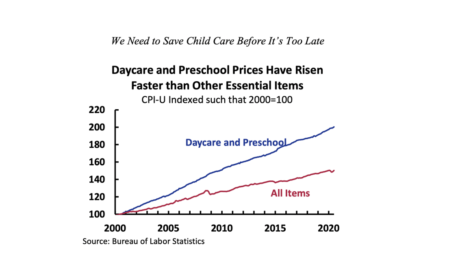U.S. Needs to Save Child Care Before It’s Too Late
The childcare system in the US was already in a critical state of inadequacy, and the COVID-19 pandemic has only made this worse. A recent report released by the U.S. Congress Joint Economic Committee (JEC) – “We Need to Save Child Care Before It’s Too late” – explores the U.S. childcare crisis in detail, outlining the shortages in child care and the consequent economics effects of those shortages.
According to the report, as of August 2020, roughly 214,000 U.S. childcare workers were out of a job and 4 out of 5 childcare providers expected to close permanently if no public assistance is provided. This is of course having a trickle-down effect on the working parents that rely on this childcare, and 13% of parents reported having to reduce their working hours.
This issue is further compounded in the many areas throughout the country considered to be “childcare deserts” where the supply of childcare falls well below the demand and for many families is not accessible due to cost constraints. Although there are assistance programs available for those in need, such as the Head Start program, many of those that qualify still do not receive assistance due to severe lack of funding. In over half of states, childcare and early childhood education exceeds the cost of college tuition, and bearing this burden is extremely difficult for lower income families.
Middle income families that do not qualify at all for government funded programs are under even more strain with the financial obligations of childcare. Infant care is in particular incredibly expensive, and a median income family home could spend anywhere from 23% to 77% of their income on the care of their infant, depending on the state. For single mothers in the median income range, this could be from 29% to 94%.
Childcare costs in the U.S. are exponentially higher than its OECD counterparts. The U.S. spends less that half the amount of its GDP on childcare in comparison to the average of other OECD nations. In fact, the U.S. spends 3 to 6 times less than France, New Zealand, and all the Nordic countries. Where in many OECD nations, childcare is free or very inexpensive, making it widely accessible, in the US, the accessibility and quality of childcare for working parents is contingents upon their economic status. A lack of accessible and affordable childcare leads to lost earnings for parents, an estimated $20 – $35 billion in total, according to the Economic Policy Institute. This in turn translates into a loss of roughly $4.2 billion dollars in federal and state tax revenue per year. The cost of childcare is skyrocketing past the rate of inflations as well, between the years 2000 and 2020, day care and preschool costs rose double that of inflation.
Extensive research has shown that accessible and affordable childcare has strong positive economic benefits and contributes to the well-being of children and parents. Without the benefit of accessible and affordable childcare, many parents, mostly women, experience reduced earnings for the duration of their careers. This also contributes tremendously to the gender wage gap. Furthermore, according to a 2015 Council of Economic Advisors report, every dollar spent on childcare and early education carries the potential to yield eight dollars in societal benefit.
Childcare workers also struggle due to low wages, poor benefits, and precarious working conditions. In 2017, an average childcare employer kept 13 workers on payroll, each of whom earned just $20,886 on average in annual compensation. In 2019, the median hourly wage of U.S. childcare workers was $11.65, a near-poverty wage. Nonetheless, employee’s compensation is the highest cost for these establishments, as they must maintain a low ratio of children to caretaker, which varies from state to state. Cost of rent is another major expense for childcare providers, but reducing the size of the facility, and therefore the rent costs, is not a viable option as crowding and lack of outdoor space has been shown to increase the risk of infections and injury within the centers.
There is still a great amount of work to be done in the U.S. The CARES Act passed in March of 2020 provided $3.5 billion of funding to states in childcare subsidies for low income families. Additionally, the inclusion of the Paycheck Protection Program (PPP) provided $2.3 billion to childcare providers across the country, enabling 460,000 childcare workers to remain employed. Although these measures were helpful, much more assistance is still needed. For the most part, smaller childcare centers and home-based programs were not able to access these PPP funds at all, with only 29% of them receiving these funds. The vast majority of childcare operations across the board, many of which single-person operations, were also not able to access these PPP funds at all. The HEROES Act, passed in the House of Representatives in May, would provide another $7 billion in relief for childcare centers and $850 to fund child and family care for essential workers. However, this legislation has stalled in the Senate.
This pandemic has dealt a devastating blow to an already inadequate childcare system in the U.S. Without desperately needed assistance, the U.S. faces the potential of losing 80% of its childcare capacity. This will in turn deprive working parents of the critical services and infrastructure needed for the economy to recover. Read the complete report “We Need to Save Child Care Before It’s Too Late.”
This blog was authored by Jenn Brown, CWE-GAM Communications Assistant
- Published in Child Care, Policy, U.S.

